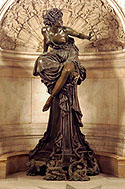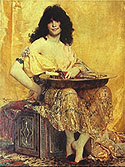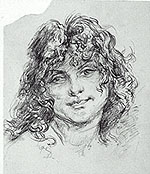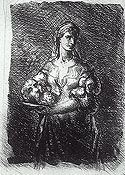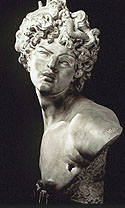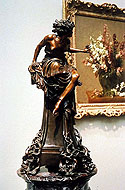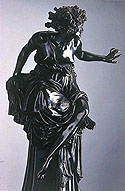The browser will either open the file, download it, or display a dialog.
|
|
"A New Formula for High Art": The Genesis and Reception of Marcello's Pythia |
|||||
|
Shortly after the opening of the celebrated Paris Opera, the architect Charles Garnier (1825–1898) published an extraordinarily detailed account of the history of the building, in which he discussed many of the artists involved in its construction and decoration. In a chapter entitled "Du grand escalier," Garnier wrote, with a mixture of caution and praise, about the only decorative work in the entire building that was not especially created for the Opera Garnier:
The sculptor to whom Garnier referred was Adèle d'Affry, the Duchess Castiglione-Colonna, otherwise known as Marcello (1836–1879). Affry, who took the pseudonym Marcello in 1863 at her Paris Salon debut, was without question the most popular female sculptor working in Paris during the Second Empire. The premature death of her husband had allowed her to return to the study and making of art, which had been her passion before her marriage. She had spent many years in Rome, where she studied sculpture and befriended numerous artists living there, including Jean-Baptiste Carpeaux (1825–1875), Georges Clairin (1843–1919) and Henri Regnault (1843–1871), who were Prix de Rome winners and pensionnaires at the French Academy. |
|||||
| Marcello's Pythia in the Opera, the sculpture for which the artist is best known, will be discussed in terms of its genesis and reception (fig. 1). This work was not the product of a lone creator struggling with her materials in order to give form to an inspired idea, but had a complex history in which not only the artist, but also models and colleagues had an important role to play.2 Additionally, ways in which the reception of this work was conditioned by the fact that its author was a woman will be explored. Although Marcello was often very well received by the press and by fellow artists, she had been shunned more than once due to her gender, her choice of media, and, as we shall see, her choice of subject. Critics either admired women who could produce "masculine" sculptures or condemned them for attempting a career in the male-dominated field of sculpture. | ||||||
| After having earned critical success in Paris and London during the early 1860s, Marcello spent the later part of the decade traveling. In 1868, she sojourned for several months in Spain in the company of Georges Clairin and Henri Regnault. She traveled to Rome in 1869 where she stayed for an entire year. Here, too, she spent much time with artist-friends, including the composer Charles François Gounod, the painter Ernest Hébert, and Regnault. While in Rome, she prepared two submissions for the 1870 Salon. One of these was a sculpture of a male Arab entitled the Abyssinian Chieftain. It would ultimately be purchased by the state, becoming part of the Musée du Luxembourg; it is currently located at the Musée d'Orsay. (A polychromed bronze version of this work recently entered the collection of the Dahesh Museum of Art in New York; fig. 5.) | ||||||
| The other submission for the Salon was Pythia, sometimes referred to as The Sibyl. Garnier acquired the work for the Opera after he had admired it in Rome in 1869. As early as 1866, the architect had contacted Marcello to ask her to create a set of caryatids for the building's Grand Foyer, but for some unknown reason this project had been abandoned. The artist was, therefore, especially excited about the potential sale of the Pythia to Garnier, writing to her mother, in a letter dated 17 May 1869, "Garnier told Regnault that he will take the Sibyl for the foyer of the Opera, how happy I would be if that succeeds! I have been working with more enthusiasm with this in mind."3 | ||||||
|
|
||||||
| There has been much speculation about the model Marcello used for Pythia. The sculptor often shared models with other artists, becoming intrigued with the features of a particular model before conceiving a subject for the piece. While in Rome, Marcello wrote of "borrowing" a model that Regnault used for one of his paintings. In a letter to her mother dated 27 July 1869, she records the commencement of a new work (not the Pythia, but a bust of a female figure that she was working on concurrently): "I have made another bust, a smiling Moorish woman, as a pendant to the grave-looking Abyssinian; the model was the little ‘Zingara Marie' [literally, Gypsy Marie], who was the inspiration for Regnault's masterpiece."4 Marcello here makes reference to Regnault's well-known Salomé, now in the Metropolitan Museum of Art, New York (figs. 2 & 3). That Marcello and Regnault shared a model was confirmed by Henri Cazalis, who noted in his study of Regnault of 1872 that "the model who served him for the composition of the head [of Salomé], and whom [Regnault] had met in Rome, also served Mme la Duchess Colona [sic] for a bust of an African woman, which she made at the same time."5 It is unclear whether Marcello used the same model for Pythia, as the bust of the smiling African woman has disappeared. However, Marcello's Pythia does share several elements with Regnault's Salomé, such as the seated pose, position of the feet, disheveled appearance, and the elaborate treatment of the hair. | ||||||
| The similarities between Marcello's Pythia and Regnault's Salomé must be seen less in terms of the traditional notion of "influence' than as the result of a complex give-and-take between two artists who shared models, saw one another on a regular basis, and perhaps even worked together. Apparently, both Marcello and Regnault started their works as simple studies of a model and only later developed these into thematic works. Both must have seen the model as a figure of strength, which caused them to think of mythical, powerful women. Regnault appears to have toyed with such titles as Hériodiade, Esclave Favorite, and Poétesse de Cordoba, before settling on Salomé.6 It is possible that this decision was inspired by an etching by Marcello, produced around 1868, when she was working alongside Regnault in Spain (fig. 4). The figure in the print stands holding a large plate with the head of the Baptist. The deep crosshatchings throughout the drawing and billowy sleeves of her dress lend a sense of energy to the image, not unlike Regnault's painting. Conversely, Marcello made a drawing after Regnault's Salomé while in its early stages, but eventually decided to turn her study into a Pythia. It is interesting to note that, while both Salomé and Pythia were powerful women, Salomé is the typical femme fatale, who used her influence to have a man killed. Pythia, on the other hand, is fortified by the divine inspiration of Apollo, and uses her power to guide those who seek her council. | ||||||
| According to Marie Lathers, Zingara Marie served only as the initial model for Regnault's Salomé (fig. 2). Regnault seems to have finished the study he had made in Rome in Morocco in 1870, using Aïscha-Tchama, a young Arab woman, who posed for him and Clairin, as a later and final model. According to the Metropolitan Museum of Art archives, he enlarged the painting to a bust-length composition called Study of an African Woman. Finally, in 1870, after adding canvas to three sides of the work, he completed the painting in Tangier, inserting the passages that included the knife and basin. Some sources indicate that Regnault's father encouraged him to enlarge the work, while later writers note that the artist did so on a suggestion from the influential Spanish painter Mariano Fortuny (1838–1874).7 | ||||||
|
|
||||||
| Similarly, Marcello's Pythia, begun as a bust that terminated at the torso, was later enlarged to include the figure's entire body and a tall tripod base. Just as Regnault used another model to complete his painting, Marcello used her own hands, arms, shoulders, and upper body to model Pythia. Louise Clément-Carpeaux, daughter of Jean-Baptiste Carpeaux and later one of his first biographers, noted many years later that her mother recognized Marcello's features in the Pythia.8 | ||||||
| Both Marcello and Regnault thus acted as modern Zeuxis, combining the features of various models to create the effects they desired. Marcello's use of her own body for the topless Pythia is especially intriguing. Surely it would have been scandalous to admit publicly that the arms, shoulders, and bare breasts of the figure shown in the Salon were modeled (and, in part, cast) from the artist's own. But it was not the first time that Marcello used her body as a model for her sculptures, as she often made drawings of herself and cast her shoulders and bust (without her head) for use as a study. She profoundly identified with all of her sculpted female figures, considering them her offspring, noting on her tombstone that her works survived her ("Elle aima le beau et le bien et ses oeuvres lui survivent"). | ||||||
| Marcello's choice of the Pythian sibyl as a subject for this sculpture reflects the artist's life-long interest in ancient stories and myths and her fascination with powerful, heroic female figures. According to the best-known version of the Delphic myth, Pythia was a priestess who served Apollo, the ancient Greek god of prophecy.9 Many women served as "Pythia" at the temple of Apollo over a period of twelve centuries. These female prophets, each known as the oracle of Delphi, were, according to legend, totally fearless. (The word "oracle," from the Latin oraculum "to speak," can refer to both a person through whom a deity is believed to speak and to the place where prophecies are spoken, as it is more commonly used.) Each priestess was protected from the fumes that rose from below because she remained in an upper-level cell in the Temple of Apollo. When a prophesy was requested, she would descend to the basement cell of the temple, mount her tripod, and breathe in sacred fumes that were emitted from a fault line below the temple. This would cause the priestess to become intoxicated and seemingly possessed, and, her body writhing violently, she would predict the future to those who beckoned to her. She also answered questions, made prophecies, and gave orders. Only there, on her tripod, inebriated by the fumes, could she experience a divine intervention or possession that allowed her to become a clairvoyant who predicts the future.10 The sibyl's power was legendary, and the greatest of men were said to have visited her for her guidance and wisdom. | ||||||
|
The three earliest stories of the Pythia are found in such ancient texts as the Homeric Hymn to Apollo, Aeschylus's Eumenides, and in the chorus of Euripides's Iphigeneia in Tauris. Although Plutarch, the Greek biographer and philosopher, wrote about the priestesses and the fumes, one of the most vivid accounts of such women comes from Book Six of Virgil's Aeneid, in which a similar priestess of Apollo rendered the oracles (in this case the word refers to the answers provided by the priestess) and mystical visions that came to her ferociously and violently:
Although traditionally the sibyl was a virgin, the passages concerning her in Virgil's text are extremely sexual. Seeing her as a powerful force fighting for and against Apollo's hold, Virgil continued:
Marcello's sculpture includes many visual codes providing a similarly sexual reading of the figure. The bare breasts, wild coiffure, and dynamic pose of the Pythia correspond with traditional analyses of the priestess. |
||||||
| Placing Marcello within a specific style or movement is not an easy task, yet her late work does prefigure the symbolist movement. Her Pythia has many symbolist characteristics, including the exploration of decadence, irrational states of mind, an interest in the occult and the supernatural, and a synthesis or combination of elements from other art forms, such as classical mythology and music (she may have been thinking here of a sibyl from an opera by Lully), to create a total artistic experience. Organic and inorganic forms, of particular interest to symbolists, metamorphose into animalier groups at the base of the sculpture. Additionally, the Pythia conforms to the femme-fatale type, another important symbolist motif. | ||||||
|
Marcello considered the Pythia her masterpiece. In a letter to Carpeaux sent from Rome and dated 30 March 1870, she described the work in detail:
In the same letter, she described the difficulties of shipping the piece to Paris and asked Carpeaux to suggest a good location at the Salon of 1870 for the sculpture:
Many of the reviews of Pythia, which was ultimately accepted and shown in the Salon of 1870, were positive. The critic Pontmartin called it "energetic, alive, palpitating, returning to the goddesses, much better than cold effigies, the feeling of these ancient symbols."15 Camille Lemonnier remarked that the figure of the sibyl "balances herself on the side of a tripod in a wild and superb attitude."16 The strongest praise came from Ernest Fillonneau, critic and director of Moniteur des arts:
On 21 June 1870, M. de Thémines, writing for La Patrie, similarly praised the sculpture:
Not all of the reviews were positive, however. A caricature published in 1870 by the popular caricaturist Cham (Amédeé-Charles Henri de Noé, 1818–1879) depicted the Pythia perched haphazardly upon a chest of drawers; having one's work chosen as a subject for Cham's caricatures was seen as a strange form of flattery and free publicity. Other critiques could be quite harsh. René Ménard, in his review of the Salon of 1870 in the Gazette des beaux-arts, considered the work inappropriate for a female artist:
Ménard was concerned mainly with the contortions of the body of Pythia, and he objected to a seemingly intoxicated female figure, feeling that passionate and reckless adventures would lead one (that is, a woman) to failure. The raw sexuality of the figure noted earlier is also palpable, and Ménard disapproved of its coming from the hand of a woman. On a similar note, the critic Goujon claimed that Marcello's Abyssinian Chieftain (see bronze version, fig. 5), of the same year and exhibited nearby at the same Salon, had a "savage arrogance" that could "not possibly have been conceived by a woman."20 Works of art exhibiting arrogance, passion, and power were not only unsuitable for women to look at, but even more improper for them to produce. |
||||||
|
That Marcello was passed over for a medal at the Salon was noted by her supporters. Fillonneau, in his apparent anger over this, went on in his review to publicly accuse the Awards Jury of favoritism:
Garnier had seen the original version of Pythia in Rome and had a second opportunity to view a bronze version at the Salon of 1870. The high volume of works produced by Barbedienne's foundry caused a seven-month delay in casting the sculpture, and, on the advice of Garnier, Marcello hired the founders Thiébaut et Fils to complete the life-sized sculpture in bronze for the Salon. The work was purchased by the state at Garnier's request on 3 June 1870 for the considerable sum of 12,000 francs. |
|||||
|
The placement of the Pythia was not originally planned for the Grand Foyer of the Opera. Special guests, performers, and wealthy season-ticket holders would enter the building from the rear and lower level of the Opera, called the Grand Vestibule or the Pavilion des Abonnés, which led directly to the grand foyer and then the Grand Stairway.22 The Pythia was the first sculpture that these privileged season-ticket holders saw upon entering the main portion of the Opera, and thus had been placed in a very favorable location. According to Garnier, the space was intended for a different work, and originally he did not envision the Pythia being placed there:
Other bronze casts and marble editions of Pythia were produced following the overall success of the piece at the Salon and later at the Opera. A marble of the bust-only version, created for the dressmaker Charles-Frederick Worth, is on view at the Musée Carnavalet (fig. 6). The Philadelphia Museum of Art owns a bronze Pythia in a decorative-sized version, cast by the successors of Thiébaut's foundry, Thiébaut Frères, Fumière and Gavignot (fig. 7). In addition, a bronze produced in 1880 by Thiébaut Frères for the original Musée Marcello, is now housed in the Musée d'art et d'histoire, Fribourg (fig. 8). |
||||||
|
Marcello found renewed praise and overall success when the Pythia was placed in the Opera, which opened to the public in 1875. While other works of 1870 by her friends, such as Regnault's Salomé and Fortuny's Vicarage, were already out of public view, Marcello's Pythia continued to bring her fame. On 2 January 1875, a writer in L'Illustration spoke of the installation of the alluring but "strange" sculpture at the Opera:
Marcello's sculpture, which she herself called bizarre, did not suffer the criticism that befell Carpeaux's La Danse, placed on the building's façade. The depiction of nude, dancing figures on the outside of a public, state-sponsored building proved to be too risqué for Second-Empire tastes; in August of 1869, La Danse became the target of a self-appointed, ink-wielding critic. By the time of the Opera's public opening, Third Republic tastes were even more subdued, and less tolerant of unreserved sexuality. Tucked under the Grand Stairway, however, Marcello's semi-nude, sexually charged Pythia escaped similar public outbursts. |
||||||
| Marcello's Pythia, certainly her masterpiece, was also one of her last sculptures. The artist had suffered from symptoms of tuberculosis for many years, and, after 1870, she exhibited and sculpted less frequently. Her paintings, to which she devoted much of her later career, were never quite popular with the public or the critics, and her largest painting, The Feschi Conspiracy (Musée d'Art et d'Histoire, Fribourg), was refused by the jury of the Salon of 1874. Marcello spent her final years in Italy, designing her tombstone, organizing her affairs, and planning a museum of her works and the works of her friends that she had collected. She had spent two decades producing unconventional art that, although sometimes causing her to be shunned by the Salon jury and art critics, won her remarkable success. As an early symbolist work, the Pythia promoted, in Fillonneau's words, a new formula of high art. Pythia, Marcello's favorite daughter, can be admired today exactly as it was in 1875, at the Opera Garnier in Paris. | ||||||
|
|
||||||
|
Author's Note: I express my thanks to the following institutions and individuals: the Pro-Helvetia/Arts Council of Switzerland, Geneva; the Schweizerisches Institut für Kunstwissenschaft, Zurich; the Musée d'Art et d'Histoire, Fribourg; the Fondation Marcello, Fribourg; and Petra Chu, Colette Guisolan-Dreyer, Brian Edward Hack, Yvonne Lehnherr, Patricia Mainardi, Anne Pingeot, Jane Mayo Roos, Maboula Soumahoro, Caroline Schuster-Cordone, the Countess Natalie Snoy et Oppeurs, Sally Webster, Magnus von Wistinghausen, and Monique von Wistinghausen. This essay is dedicated to Dr. Hans Lüthy, a great champion of Swiss art and a Marcello enthusiast. 1. Charles Garnier, Le nouvel Opéra (Paris: Éditions du Linteau, 2001; orig. ed., Paris, Ducher & Cie., 1878–81), p. 296: "Puisque j'en suis sur le chapitre des femmes, je veux en profiter pour dire tout de suite quelques mots sur une oeuvre intéressante due à l'une d'elles, madame la duchessse Colonna (en sculpture Marcello). C'est elle qui a modelé la statue de la Pythie qui se trouve sous la voûte centrale, et c'est une justice à lui rendre que de reconnaître que c'est une oeuvre virile, robuste et loin d'être indifférente. Cette statue a été critiquée par les uns, louée par les autres; c'est le sort des choses humaines; c'est même celui des choses divines; mais ces discussions n'enlèvent rien à son allure énergique et à sa silhouette caractérisée." 2. The sociologist Howard S. Becker discussed this phenomenon in his Art Worlds (Berkeley: University of California, 1982). 3. Letter from the Duchess Colonna to her mother, the Countess Lucie d'Affry, dated 17 May 1869, Archives Fondation Marcello: "Garnier a dit à Regnault qu'il prendra la sibylle pour le foyer de l'Opéra, quel bonheur si cela réussit! Je travaille avec bien plus de zèle avec cette idée!" 4. Comtesse Odette d'Alcantara, Marcello: Adèle d'Affry, Duchesse Castiglione-Colonna, 1836–1879, sa vie, son oeuvre, sa pensée et ses amis (Geneva: Éditions Générales, 1961), p. 136: "J'ai fait un autre buste, une femme mauresque souriante, comme pendant au grave Abyssin, avec comme modèle la petite Zingara Marie, dont Regnault a fait un chef-d'oeuvre…." 5. Henri Cazalis, Henri Regnault: sa vie et son oeuvre (Paris: A. Lemerre, 1872), p. 73: "Le modèle qui lui servit pour la composer la tête [of Salomé], et qu'il rencontra à Rome, servit aussi à Mme la duchesse Colona [sic] pour un buste de femme africain qu'elle fit à la même époque." It is unclear for which work Marcello used Regnault's model; although she may have easily used Zingara Marie for the Pythia, Marcello was also working on other busts of female figures at the same time. 6. New York, Archives of the Metropolitan Museum of Art, Department of Accessions and Catalogues. 7. Lucy H. Hooper, "From Abroad: Paris Letters." Appleton's Journal: A Magazine of General Literature 14 (31 July 1875), pp. 154-56. Retrieved on 14 August 2001 from http://cdl.library.cornell.edu/moa. Hooper noted that Fortuny said he was not entering the Salon of 1870 because he had nothing to exhibit, but suggested that Regnault "take that head which you sketched lately and put a body to it; nothing could be better." 8. In discussing the work and its supporters, Clément-Carpeaux wrote: "Cette figure de la Pythie (portrait fort ressemblant de la duchesse elle-même, m'a dit ma mère), est aujourd'hui exposé dans le vestibule de l'Opéra, sous le grand escalier du rez-de-chaussée. Évidemment, l'appui de Carpeaux et plus encore celui du marquis de Piennes, tout dévoué à la charmante artiste, ne furent pas étrangers à ce succès." Louise Clément-Carpeaux, La vérité sur l'oeuvre et la vie de J.-B. Carpeaux (1827–1875) (Paris: Dousset et Bigerelle, 1934–35), p. 23. 9. The best secondary sources on the Delphic myths are H.W. Parke and D.E.W. Wormell, The Delphic Oracle, 2 vols. (Oxford: Blackwell, 1959); Joseph Fontenrose, Python: A Study of the Delphic Myth and its Origins (Berkeley: University of California at Los Angeles, 1959); and Roger Lipsey, Have You Been to Delphi? Tales of the Ancient Oracle for Modern Minds (Albany: State University of New York, 2001). 10. Once thought to be simply the product of myth, the legends of the oracles at Delphi may have been based on fact. Potent gases, particularly ethylene, ethane, and methane, have been found to actually emit from the floor of the Temple of Apollo in Greece. These gases are known to produce altered mental states. See William J. Broad, "For Delphic Oracle, Fumes and Visions," New York Times (Science Times, Section F), 19 March 2002, pp. 1, 4. 11. Virgil, The Aeneid, trans. David West (New York and London: Penguin Classics, 1990; original, ca. 29 B.C.), pp. 132, 134. 12. Virgil 1990, pp. 134–35. 13. Clément-Carpeaux 1934–35, p. 22: "Mon cher Carpeaux, j'ai envoyé une figure importante au Salon de cette année; c'est une Pythie sur le trépied, une sorte de gitana agitée par le don fatidique. C'est bizarre, énergique, et pas du tout systématique, aussi vais-je avoir contre moi tout ce qui s'enrégimente. C'est beaucoup de monde en France. J'espère que vous prêterez à ma defense votre amitié et la sympathie naturelle qu'une nature généreuse et originale, telle que la vôtre, doit ressentir pout tout ce qui ose lutter, répondant par la persévérance au travail à de continuelles duretés de la part du jury des récompenses." 14. Clément-Carpeaux 1934–35, p. 22: "Deux fois la figure a croulé, je l'ai recommencée et n'ai bougé d'un an jusqu'à ce qu'elle fût terminée. Dans le voyage de Paris elle s'est brisée en cent morceaux, ce qui a exigé plus de temps qu'on ne comptait pour la fonte, — vous la voyez donc sous l'aspect défavorable du plâtre, mais Thiébault [sic] promet le bronze pour l'ouverture du Salon, et je vous prie de demander pour elle une bonne place, capable de favoriser l'impression sur le public." 15. A. de Pontmartin, "Salon de 1870, Sculpture," L'Univers illustré, 18 June 1870, p. 394. 16. Camille Lemonnier, Salon de Paris 1870 (Paris: Morel et Cie., 1870), p. 231: "Je cite encore MM. Chevet, Deleplanche, Morice, Cordier, Rivey, Gouget et surtout cet original et fougueux bifrons Marcello, si savant et si ignorant, dont la Pythie, cambrée en manière de femme apache, se crispe sur le bord d'un trépied dans une attitude extravagante et superbe." 17. Ernest Fillonneau, "Salon de 1870: Sculpture," Moniteur des arts (24 May 1870), p. 2: "Le succès que nous prédisions, avant l'exposition, à la Pythie de Marcello, s'est pleinement réalisé, et cette oeuvre magistrale partage avec la Salomé d'Henri Regnault, du Salon de peinture, les honneurs de la discussion. La partie éclairée du public s'accorde à reconnaître, surtout dans la Pythie, une formule nouvelle du grand art, la recherche passionnée du beau sur une donnée philosophique, la réalisation, enfin, d'une des conceptions les plus hardies et les plus saisissantes de la statuaire contemporaine…. Quant au buste de Chef Abyssin, également par Marcello, il n'est et ne peut être contesté par personne." 18. M. de Thémines, "Salon de 1870. XIV," La Patrie (June 21, 1870), n. p.: "Voici la Pythie de Marcello (dont nous respectons le pseudonyme). Comme toutes les oeuvres qui sont marquées au sceau de génie, ce bronze a des admirateurs très fervents, comme il a des détracteurs. Certes, il y a dans cette oeuvre une fougue, une vigueur, une témérité de composition très rare. On sent que l'auteur a le feu sacré; en modelant sa Pythie, il a dù s'assimiler la puissance surnaturelle du modèle. La prêtresse d'Apollon est sur son trépied, inspirée par ce dieu, prononçant ses sombres responses. On a prétendu que la statuaire exige le calme et la gravité. C'est trop généraliser et c'est lui ôter la moitié de ses faculitiés. Pour avoir enfreint cette loi, l'auteur de Laocoön n'a pas moins laissé une oeuvre impérissable. On ne peut donner la même pose et la même expression à une Minerve et à Pythie. N'oublions pas le précepte d'Horace: Sit Medea ferox, etc. A côte du bronze de Marcello on admire son chef abyssin, buste en marbre et bronze; d'un grand caractère et d'un grand style." 19. René Ménard, "Salon de 1870," Gazette des beaux-arts (July 1870), p. 64: "La grande dame qui signe ses ouvrages du nom de Marcello a fait, cette année, une tentative plus audacieuse que réussie. Sa Pythie ressemble bien plus à une sorcière du moyen âge qu'à la prêtresse inspirée d'Apollon….Certes, nous sommes loin de contester le talent et l'effort dépensés sur ce bronze; mais nous croyons que le sculpture n'est pas faite pour le mélodrame, et il y a presque un sacrilége à affubler d'un nom grec un cauchemar de l'an mil….C'est un sujet terrible pour un sculpteur que cette folie solennelle d'une Pythie en délire qui proclame les arrêts du Destin….La Pythie de Delphes, assise sur son trépied sacré, et exaltée par le dieu qui parle en elle, est en proie à une ivresse grandiose et lyrique; tout son corps s'anime, et, d'un accent inspire, elle prédit l'avenir. L'austérité tragique de son movement n'a rien de contourné ni pénible, et sa fureur rhythmée proclame des arrêts retentissants et solennels." 20. J. Goujon, Salon of 1870 (Paris: Goujon, 1870), p. 160. 21. Fillonneau 1870, p. 2: "Et le jury? qu'a-t-il fait devant ces deux ouvrages hors ligne, témoins éloquents d'un énorme travail, résultants inattendus et inespérés d'efforts superbes? Le jury n'a rien fait….Hélas! ce n'est pas la première fois qu'un jury recule devant l'évidence et se soustrait à la vérité. Nous croyons savoir et nous aimons à croire que parmi ces artistes, tous n'ont pas plaidé uniquement en faveur de leurs élèves et de leurs camarades, mais la majorité regrettera plus tard de l'avoir emporté: quant à Marcello, elle peut se consoler. Le public digne de ce nom l'acclaime chaque jour, et un des plus grands artistes de ce temps-ci à dit: ‘J'aimerais mieux avoir fait la Pythie et le buste de chef arabe que d'avoir remporté n'importe quelle médaille!' 22. Christopher Curtis Mead, Charles Garnier's Paris Opera: Architectural Empathy and the Renaissance of French Classicism (Cambridge, Mass.: MIT Press, 1991), pp. 118–19. 23. Garnier 2001, pp. 296–97: "Cette figure n'était pas faite pour l'Opéra. La niche qui la reçoit devait abriter une statue assise d'Orphée, dont, pour diverses raisons, la commande avait été ajournée. C'est à Rome que la duchesse Colonna modelait sa Pythie, et c'est à Rome que je la vis, alors que le statue était encore en terre. Elle me plut fort, mais je ne pensais guère alors qu'elle dût se loger dans le théâtre. Ce n'est que deux ans plus tard, alors que La Pythie avait été exposée à Paris, après son moulage en bronze, que, ne voyant pas Orphée venir, je voulus me rendre compte de l'effet qu'elle pourrait produire sous l'escalier. Cet effet me parut satisfaisant et je demandai au ministre de faire l'acquisition de la statue. C'est ce qui eut lieu, et à la place d'une figure en marbre blanc, représentant calmement un dieu fort calme j'eus un bronze tourmenté, représentant une prêtresse d'Apollon se tourmentant sur son trépied! Je ne regrette pas cette substitution et, ce me semble, le public est du même avis." 24. Anonymous author, "Le nouvel Opéra," L'Illustration, 2 January 1875, p. 7: "Au milieu de ce bassin garni de fleurs et de plantes aquatiques, est placée la pythonisse en bronze de Marcello. On sait que sous ce pseudonyme se cache Mme la princess [sic] Colonna, qui, ces jours derniers, est venue présider elle-même au placement définitif de cette statue dont le caractère étrange et l'allure inspirée ont été généralement remarqués." |


